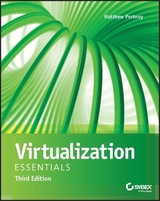
Virtualization Essentials
Sybex Inc.,U.S. (Verlag)
978-1-119-26772-0 (ISBN)
- Titel erscheint in neuer Auflage
- Artikel merken
Learn virtualization skills by building your own virtual machine Virtualization Essentials, Second Edition provides new and aspiring IT professionals with immersive training in working with virtualization environments. Clear, straightforward discussion simplifies complex concepts, and the hands-on tutorial approach helps you quickly get up to speed on the fundamentals. You'll begin by learning what virtualization is and how it works within the computing environment, then you'll dive right into building your own virtual machine. You'll learn how to set up the CPU, memory, storage, networking, and more as you master the skills that put you in-demand on the job market. Each chapter focuses on a specific goal, and concludes with review questions that test your understanding as well as suggested exercises that help you reinforce what you've learned.
As more and more companies are leveraging virtualization, it's imperative that IT professionals have the skills and knowledge to interface with virtualization-centric infrastructures. This book takes a learning-by-doing approach to give you hands-on training and a core understanding of virtualization.
Understand how virtualization works
Create a virtual machine by scratch and migration
Configure and manage basic components and supporting devices
Develop the necessary skill set to work in today's virtual world
Virtualization was initially used to build test labs, but its use has expanded to become best practice for a tremendous variety of IT solutions including high availability, business continuity, dynamic IT, and more. Cloud computing and DevOps rely on virtualization technologies, and the exponential spread of these and similar applications make virtualization proficiency a major value-add for any IT professional. Virtualization Essentials, Second Edition provides accessible, user-friendly, informative virtualization training for the forward-looking pro.
About the Author Matthew Portnoy is a 30-year veteran of the IT industry. A Staff System Engineer at VMware, he is also an adjunct professor at Wake Tech Community College, where he has taught CIS classes since 2007. He has presented at VMworld, the leading virtualization conference, as well as at many other industry events and tradeshows including VMware User Group events.
Introduction xvii
Chapter 1 Understanding Virtualization 1
Describing Virtualization 1
Microsoft Windows Drives Server Growth 3
Explaining Moore’s Law 6
Understanding the Importance of Virtualization 9
Examining Today’s Trends 12
Virtualization and Cloud Computing 14
Understanding Virtualization Software Operation 15
Virtualizing Servers 16
Virtualizing Desktops 17
Virtualizing Applications 18
Chapter 2 Understanding Hypervisors 21
Describing a Hypervisor 21
Exploring the History of Hypervisors 22
Understanding Type 1 Hypervisors 23
Understanding Type 2 Hypervisors 25
Understanding the Role of a Hypervisor 26
Holodecks and Traffic Cops 26
Resource Allocation 27
Comparing Today’s Hypervisors 29
VMware ESX 29
Citrix Xen 31
Microsoft Hyper-V 33
Other Solutions 34
Chapter 3 Understanding Virtual Machines 37
Describing a Virtual Machine 37
Examining CPUs in a Virtual Machine 40
Examining Memory in a Virtual Machine 41
Examining Network Resources in a Virtual Machine 42
Examining Storage in a Virtual Machine 43
Understanding How a Virtual Machine Works 45
Working with Virtual Machines 47
Understanding Virtual Machine Clones 48
Understanding Templates 49
Understanding Snapshots 50
Understanding OVF 51
Understanding Containers 52
Chapter 4 Creating a Virtual Machine 55
Performing P2V Conversions 55
Investigating the Physical-to-Virtual Process 56
Hot and Cold Cloning 57
Loading Your Environment 58
Loading VMware Workstation Player 59
Exploring VMware Workstation Player 65
Loading VirtualBox 68
Building a New Virtual Machine 73
Thinking about VM Configuration 74
Creating a First VM 75
Chapter 5 Installing Windows on a Virtual Machine 81
Loading Windows into a Virtual Machine 81
Installing Windows 10 82
Installing VMware Tools 93
Understanding Configuration Options 97
Optimizing a New Virtual Machine 103
Chapter 6 Installing Linux on a Virtual Machine 107
Loading Linux into a Virtual Machine 107
Exploring Oracle VM VirtualBox 108
Installing Linux into a Virtual Machine 111
Installing VirtualBox Guest Additions 123
Understanding Configuration Options 125
Optimizing a New Linux Virtual Machine 129
Chapter 7 Managing CPUs for a Virtual Machine 133
Understanding CPU Virtualization 133
Configuring VM CPU Options 137
Tuning Practices for VM CPUs 138
Choosing Multiple vCPUs vs a Single vCPU 139
Hyper-Threading 140
Working with Intel and AMD Servers 141
Chapter 8 Managing Memory for a Virtual Machine 143
Understanding Memory Virtualization 143
Configuring VM Memory Options 146
Tuning Practices for VM Memory 148
Calculating Memory Overhead 148
Memory Optimizations 150
Chapter 9 Managing Storage for a Virtual Machine 157
Understanding Storage Virtualization 157
Configuring VM Storage Options 162
Tuning Practices for VM Storage 169
Chapter 10 Managing Networking for a Virtual Machine 177
Understanding Network Virtualization 177
Configuring VM Network Options 187
Tuning Practices for Virtual Networks 192
Chapter 11 Copying a Virtual Machine 197
Cloning a Virtual Machine 197
Working with Templates 207
Saving a Virtual Machine State 212
Creating a Snapshot 214
Merging Snapshots 218
Chapter 12 Managing Additional Devices in Virtual Machines 221
Using Virtual Machine Tools 222
Understanding Virtual Devices 224
Configuring a CD/DVD Drive 224
Configuring a Floppy Disk Drive 225
Configuring a Sound Card 229
Configuring USB Devices 230
Configuring Graphic Displays 232
Configuring Other Devices 233
Chapter 13 Understanding Availability 239
Increasing Availability 239
Protecting a Virtual Machine 242
Protecting Multiple Virtual Machines 246
Protecting Data Centers 251
Chapter 14 Understanding Applications in a Virtual Machine 255
Examining Virtual Infrastructure Performance Capabilities 255
Deploying Applications in a Virtual Environment 260
Understanding Virtual Appliances and vApps 269
Open Stack and Containers 271
Appendix Answers to Additional Exercises 275
Glossary 287
Index 293
| Erscheinungsdatum | 23.09.2016 |
|---|---|
| Verlagsort | New York |
| Sprache | englisch |
| Maße | 188 x 234 mm |
| Gewicht | 454 g |
| Themenwelt | Mathematik / Informatik ► Informatik ► Netzwerke |
| Technik ► Elektrotechnik / Energietechnik | |
| ISBN-10 | 1-119-26772-2 / 1119267722 |
| ISBN-13 | 978-1-119-26772-0 / 9781119267720 |
| Zustand | Neuware |
| Haben Sie eine Frage zum Produkt? |
aus dem Bereich



